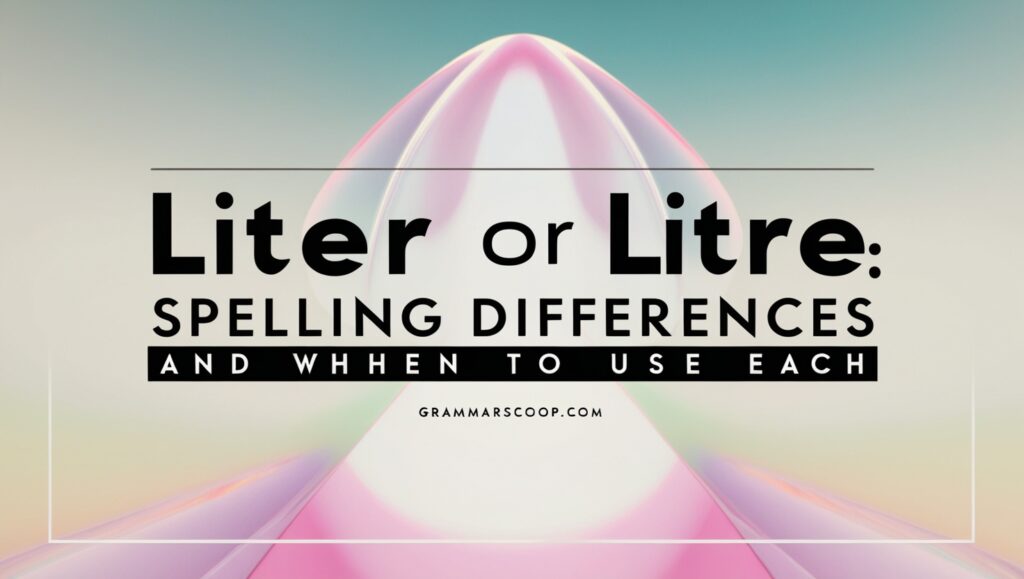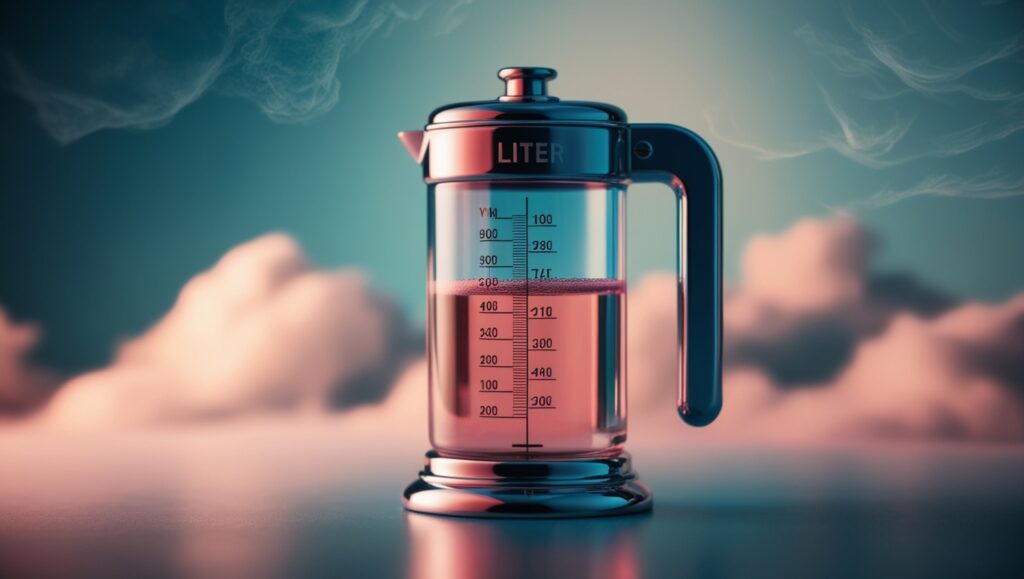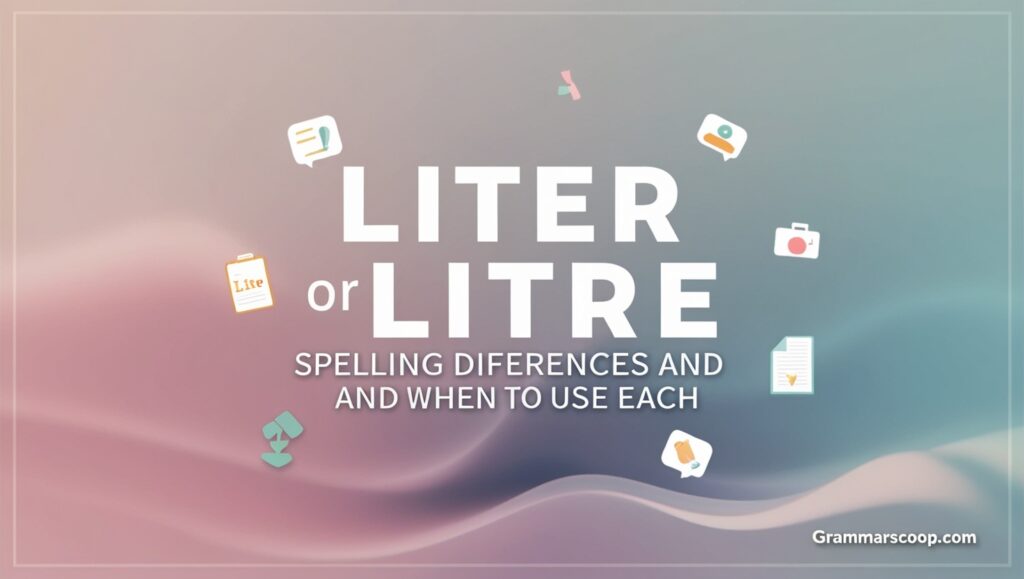Ever stumbled on whether to use liter or litre in your writing? You’re not alone. The debate between litre and liter goes beyond just spelling—it’s rooted in geography, history, and even scientific conventions.
In this article, we’ll break down the difference between litre and liter, explain when to use each, explore British English vs American English spelling, and guide you through style choices in academic, scientific, and international contexts.
Quick Summary
The difference between litre and liter comes down to regional spelling preferences. British English uses litre, while American English uses liter—but both refer to the same unit of volume in the metric system: 1 liter = 1,000 milliliters. This spelling distinction traces back to historical language evolution, particularly the influence of Noah Webster’s American spelling reforms. In academic, scientific, or international contexts, either spelling may be used—just ensure consistency. The abbreviation “L” (capitalized) is universally accepted to avoid confusion with the number 1. Whether you’re writing about fuel, beverages, or laboratory measurements, the key is knowing your audience and applying the appropriate spelling.
Why the Spelling Confusion Exists

The confusion comes from the age-old divide between British English and American English. While both spellings refer to the same unit of volume, the form you use depends on where you are—and sometimes who you’re writing for.
Quick facts:
- Both spellings are correct—in the right context.
- Litres or liters refer to the same quantity: 1 liter = 1 litre = 1,000 milliliters.
- The spelling depends on regional conventions and style guides.
What Does Liter or Litre Actually Mean?
Both liter and litre refer to a unit of volume in the metric system, equivalent to 1,000 cubic centimeters (cm³) or 1 cubic decimeter (dm³).
Common uses include:
- Measuring liquids (water, milk, oil)
- Fuel quantities (petrol, gas)
- Scientific and laboratory measurements
- Beverage packaging (like a 2-liter soda)
Metric Equivalents:
| Measurement | Equivalent in Liters |
|---|---|
| 1 milliliter (mL) | 0.001 L |
| 1000 mL | 1 L |
| 1 liter (or litre) | ~0.264 US gallons |
| 5 liters | ~1.32 US gallons |
The metric system is used globally in science and everyday life, making litre or liter one of the most recognized volume measurement units worldwide.
Litre vs Liter — Regional Spelling Standards
British English Preference
In the UK, Canada, Australia, New Zealand, and many Commonwealth countries, litre is the standard spelling. You’ll see this version on:
- Food and drink packaging
- Fuel station signs
- Government publications
Example:
“The average adult should drink at least 2 litres of water per day.”
American English Preference
In the United States, the spelling liter is used exclusively in education, business, and packaging.
Example:
“This bottle contains 1.5 liters of soda.”
American English uses liter, aligning with other simplified spellings (like color vs colour, center vs centre). This is largely thanks to Noah Webster, who reformed American spelling in the early 1800s to make it more phonetic and distinct from British English.
International Standards (SI Units)

Both litre and liter are acceptable in scientific contexts as long as consistency is maintained. The International System of Units (SI) officially recognizes L as the symbol, regardless of spelling.
- L is used instead of l to prevent confusion with the number 1.
- 1 L = 1000 mL
ISO and BIPM (International Bureau of Weights and Measures) both allow either spelling, depending on region.
How to Know Which Spelling to Use
Follow Regional Norms
If you’re writing for a regional audience:
- Use litre for British-style audiences.
- Use liter for American-style audiences.
This applies to everything from marketing content to recipe books.
Academic and Scientific Writing
Always follow the relevant style guide when writing for academic or scientific purposes.
Style Guide Preferences:
| Style Guide | Preferred Spelling | Notes |
|---|---|---|
| APA (US) | Liter | Follows US English |
| MLA | Depends on audience | Use consistent spelling |
| Chicago Manual of Style | Liter | US standard |
| Oxford Style Manual | Litre | British standard |
Consistency is key. Pick one spelling and stick with it throughout your text.
Writing for Global or Mixed Audiences
When in doubt:
- Choose liter for American-influenced markets (like the US, Philippines).
- Choose litre for European or Commonwealth-influenced regions.
- In scientific publications, use “L” as a neutral abbreviation.
Explore further:
- High-Quality Or High Quality: Which One Is Correct?
- Plural of Journey: Is It Journeys or Journies?
- Quit vs Resign: Clear Up the Confusion Once and For All
- Hyperbole Vs Metaphor: Definition, Examples & Key Differences
- What’s the Past Tense of Panic?
L or l: How to Abbreviate Liter or Litre
Both litre or liter are abbreviated using L or l, but most scientific communities now prefer capital “L” to avoid confusion with the digit 1.
Abbreviation tips:
- 1000 milliliters = 1 L (not 1 l)
- 2 L of water is clearer than 2 l of water
Standard Abbreviations:
| Unit | Abbreviation |
|---|---|
| Liter / Litre | L |
| Milliliter | mL |
| Centiliter | cL |
| Deciliter | dL |
Even packaging labels around the world have adopted L, even when using different spellings like litre.
Common Misconceptions: Litre vs Lite
People often confuse litre or liter with the term lite. Don’t fall into that trap.
- Lite is a marketing term, not a spelling of liter.
- Used to suggest “low calorie” or “lightweight” in food and drink products.
Examples:
- “Bud Light” might be labeled as Bud Lite for branding.
- “Lite cheese” = reduced fat, not a volume measurement.
So remember: lite ≠ liter or litre
Real-World Usage Examples
Sentences Using ‘Litre’ (British Style)
- “I bought a 5 litre can of engine oil.”
- “The UK recommends consuming at least 1.2 litres of water daily.”
Sentences Using ‘Liter’ (American Style)
- “A 2 liter soda bottle is standard in the U.S.”
- “This car gets about 6 liters per 100 km.”
Both are grammatically correct, depending on location.
Etymology of Liter or Litre
The word litre has its roots in French, coming from the old French word litron, which referred to a unit of volume. That word likely descended from the Medieval Latin litra, which itself came from the Greek litra—a unit of weight.
Timeline:
- 1795: The French metric system was established.
- 1824: UK adopted the imperial system, but the metric system (and litre) persisted in Europe.
- 1806–1828: Noah Webster introduced spelling reforms, changing litre to liter in the U.S.
This difference is one of many born from Webster’s goal to simplify American English.
Quick Reference Table
Here’s a handy breakdown of where and how to use each spelling of litre or liter:
| Region | Standard Spelling | Example | Notes |
|---|---|---|---|
| United States | Liter | “2 liters of water” | Followed in all official and everyday use |
| United Kingdom | Litre | “2 litres of petrol” | Standard across all UK publications |
| Australia | Litre | “3 litres of milk” | Same as British English |
| Canada | Litre | “1 litre bottle” | Metric with British spelling |
| Scientific | Liter / Litre | “100 mL = 0.1 L” | Abbreviated as “L” globally |
FAQs About Liter vs Litre
- Which spelling is correct—litre or liter?
Both are correct, depending on your region. British English uses litre, while American English uses liter. - Is it 2 liters or 2 litres?
In the U.S., write 2 liters.
In the UK or Australia, write 2 litres. - Is it 1 liter or 1 litre?
Same rule applies: liter in American contexts, litre elsewhere. - Is it 100 liter or 100 litre?
Use litre or liter based on your audience. Scientifically, write 100 L. - Why do British people use litre?
Because British English preserves traditional spellings and follows the French-influenced version of the metric system. - Is it meter or metre—and is that related?
Yes, it’s the same idea:
Meter = American English
Metre = British English
Both are correct for measuring distance.
- Is lite ever a valid spelling for liter?
No. Lite is slang or marketing jargon. It means light (in calories or weight), not a unit of measurement.
Conclusion:
In the battle of Liter Or Litre, both sides win—as long as you choose wisely.
- Writing for the U.S.? Stick with liter.
- Publishing in the UK, Australia, or Canada? Use litre.
- Doing scientific writing? Use L for abbreviation, and stay consistent with your chosen spelling.
The key is clarity. Let your audience, purpose, and regional norms guide your choice. Whether you’re measuring fuel, writing a report, or labeling a product, getting the liter spelling right shows precision and professionalism.
Final Tip:
If you’re unsure which spelling to use, look at what your target readers expect. It’s a small detail, but it makes a big difference—especially in a world where words carry weight.

Lisa Morris is a seasoned blogger and language enthusiast with a passion for making grammar simple and engaging. At Grammar Scoop, she shares clear, concise tips that help readers master the rules of English with confidence.






